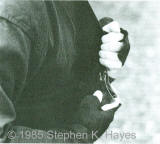
As reflected in the literal translation of the word shuriken itself,
learning the proper method of releasing the blade is the most important
aspect of shuriken throwing practice. To begin training with the
throwing blades, whether the straight bo shuriken or the
multipointed hira shuriken, it is crucial to first get used to the
feel of correctly releasing the blade for accurate flight.For Hira
Shuriken Training:
Begin your training by lightly tossing the blade straight into a wooden or
Styrofoam target, without any concern whatsoever for distance or power.
In this initial stage, the target itself does not need to be more than
three or four feet away. Distance can be accommodated later, once a
proper throw has been developed. Power will come naturally after
that, as a product of experience and competence.
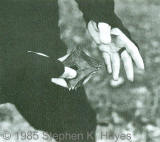 A
light tensing of the fingers and wrist at the moment of release will
create the proper feel for a straight and accurate throw. Work on
developing the feeling that the blade seems to slip out of your hand by
itself, rather than the feeling of flinging or slamming the shuriken into
the target with the muscles of the arm. By allowing the blade to
slip from your grasp at just the right instant, you cause the blade to cut
through the air with the proper trajectory. A
light tensing of the fingers and wrist at the moment of release will
create the proper feel for a straight and accurate throw. Work on
developing the feeling that the blade seems to slip out of your hand by
itself, rather than the feeling of flinging or slamming the shuriken into
the target with the muscles of the arm. By allowing the blade to
slip from your grasp at just the right instant, you cause the blade to cut
through the air with the proper trajectory.
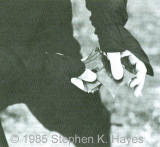 The
star-shaped plate shuriken can be stacked in the left and slid off one at
a time for throwing with the right hand. The shuriken are held on a
horizontal plane in the palm of the left hand, and the outer edge of the
right thumb tip catches in the shuriken's center hole to slide the blade
off the stack and send it on its way to the target. This throwing
method creates a rapid-fire succession of blade hits that can "track" the
target as it moves toward you. The
star-shaped plate shuriken can be stacked in the left and slid off one at
a time for throwing with the right hand. The shuriken are held on a
horizontal plane in the palm of the left hand, and the outer edge of the
right thumb tip catches in the shuriken's center hole to slide the blade
off the stack and send it on its way to the target. This throwing
method creates a rapid-fire succession of blade hits that can "track" the
target as it moves toward you.
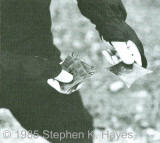 Straight
spike or bar shuriken can be held in a bundle in the left hand and
extracted one at a time for throwing with the right hand. The entire
bundle can be lifted slightly with the left hand following the right hand
as it draws the blade for each throw. The long narrow shuriken are
held in the hand lightly, with the fingertips gently supporting the spike
or bar in place for throwing. Straight
spike or bar shuriken can be held in a bundle in the left hand and
extracted one at a time for throwing with the right hand. The entire
bundle can be lifted slightly with the left hand following the right hand
as it draws the blade for each throw. The long narrow shuriken are
held in the hand lightly, with the fingertips gently supporting the spike
or bar in place for throwing.
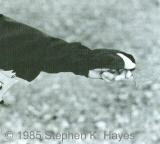 Power
and accuracy in shuriken throwing are generated by moving the body along
with the throwing hand action. The body can rock back and forth,
pulling back to ready each blade and rocking forward on the knees for each
throw, or the rear foot can slide into forward position with the throw.
The feeling of body weight behind the blade throwing action is similar to
that of effectively using the body weight in motion to generate power for
punches in the ninja's taijutsu unarmed combat method.
Indeed, without a proper grounding in the principles of taijutsu, it is
difficult to ever gain a combat mastery of the throwing blades. Power
and accuracy in shuriken throwing are generated by moving the body along
with the throwing hand action. The body can rock back and forth,
pulling back to ready each blade and rocking forward on the knees for each
throw, or the rear foot can slide into forward position with the throw.
The feeling of body weight behind the blade throwing action is similar to
that of effectively using the body weight in motion to generate power for
punches in the ninja's taijutsu unarmed combat method.
Indeed, without a proper grounding in the principles of taijutsu, it is
difficult to ever gain a combat mastery of the throwing blades.
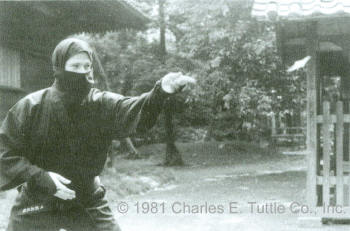 The
most common mistake encountered in shuriken practice throwing is the use
of a flinging arm and a solid stance to project the missiles at their
target. As the arm fans out horizontally across the midsection, the
hand must release the blade at precisely the correct degree of the flat
arc, with just the right timing, when throwing in this manner. This
is extremely difficult, and can usually be accomplished only by standing
in one spot and investing countless hours in unnecessary drill. In
the heat of life-saving action, standing in one spot like a pub tournament
dart thrower would most likely be a fatal mistake in tactics. It is
much simpler to learn to throw by projecting the arm in a straight path
with the moving body providing power and alignment accuracy, and therefore
developing a much more reliable fighting skill with the ninja's shuriken. The
most common mistake encountered in shuriken practice throwing is the use
of a flinging arm and a solid stance to project the missiles at their
target. As the arm fans out horizontally across the midsection, the
hand must release the blade at precisely the correct degree of the flat
arc, with just the right timing, when throwing in this manner. This
is extremely difficult, and can usually be accomplished only by standing
in one spot and investing countless hours in unnecessary drill. In
the heat of life-saving action, standing in one spot like a pub tournament
dart thrower would most likely be a fatal mistake in tactics. It is
much simpler to learn to throw by projecting the arm in a straight path
with the moving body providing power and alignment accuracy, and therefore
developing a much more reliable fighting skill with the ninja's shuriken.
The process of throwing the flat shuriken for
self-protection is one that blends actions of the eyes, breath, knees and
ankles, torso, and, of course, arm and wrist. The body rocks forward
with each throw to provide flying and cutting power to the blade.
Avoid the futility of freezing the body in position and attempting to
generate power from the arm alone. The body rocks back each time a
new blade is taken into hand, so that the forward power motion can be set
up for the next throw. Be sure to coordinate your breath with your
body action; pull air in with each return to ready position and push air
out with each movement forward to release the blade.
© 1985 Stephen K. Hayes
-----------------------------------------------------------------------------------
The Bo Shuriken in flight:
The shuriken travels through the air to the
target in 3 different ways, depending upon the school, grip, and throw.
The "direct hit" method, jikidaho or choku-da, involves
holding the blade with the point out, towards the target. This method is
employed in the Negishi Ryu, and also as a short distance throw in the
Shirai, Jikishin and other Ryu.

The second way that the blade turns, the "turning
hit", is called hantendaho, or Ikkaiten-da, and involves
holding the blade with the tip pointing into the palm. During its travel
through the air to the target, the blade turns 180 deg, or 1 turn. This
method is employed by the Shirai and other Ryu. (see fig. 23, below)
but not by Negishi Ryu, however I believe nowadays students of Negishi Ryu
also learn the throws and about the blades of other Ryu, including Shirai.

The third way a blade turns, the "multi turn"
method, or dakaiten-da, has the blade turning 360 deg. or more as
it flies through the air. This method is employed by the hira shuriken
schools, where the many points of the star shaped blade will rotate
and have no difficulty piercing the target at any distance. This method is
also employed by the Shirai Ryu over long distance throws, (up to 18
steps). (Not illustrated.)
-----------------------------------------------------------------------------------
Be
careful: While typically not capable of mortally wounding a person, these
weapons can be quite nasty. You can be fined and put in jail for using
these on animals!
|


 A
light tensing of the fingers and wrist at the moment of release will
create the proper feel for a straight and accurate throw. Work on
developing the feeling that the blade seems to slip out of your hand by
itself, rather than the feeling of flinging or slamming the shuriken into
the target with the muscles of the arm. By allowing the blade to
slip from your grasp at just the right instant, you cause the blade to cut
through the air with the proper trajectory.
A
light tensing of the fingers and wrist at the moment of release will
create the proper feel for a straight and accurate throw. Work on
developing the feeling that the blade seems to slip out of your hand by
itself, rather than the feeling of flinging or slamming the shuriken into
the target with the muscles of the arm. By allowing the blade to
slip from your grasp at just the right instant, you cause the blade to cut
through the air with the proper trajectory. The
star-shaped plate shuriken can be stacked in the left and slid off one at
a time for throwing with the right hand. The shuriken are held on a
horizontal plane in the palm of the left hand, and the outer edge of the
right thumb tip catches in the shuriken's center hole to slide the blade
off the stack and send it on its way to the target. This throwing
method creates a rapid-fire succession of blade hits that can "track" the
target as it moves toward you.
The
star-shaped plate shuriken can be stacked in the left and slid off one at
a time for throwing with the right hand. The shuriken are held on a
horizontal plane in the palm of the left hand, and the outer edge of the
right thumb tip catches in the shuriken's center hole to slide the blade
off the stack and send it on its way to the target. This throwing
method creates a rapid-fire succession of blade hits that can "track" the
target as it moves toward you. Straight
spike or bar shuriken can be held in a bundle in the left hand and
extracted one at a time for throwing with the right hand. The entire
bundle can be lifted slightly with the left hand following the right hand
as it draws the blade for each throw. The long narrow shuriken are
held in the hand lightly, with the fingertips gently supporting the spike
or bar in place for throwing.
Straight
spike or bar shuriken can be held in a bundle in the left hand and
extracted one at a time for throwing with the right hand. The entire
bundle can be lifted slightly with the left hand following the right hand
as it draws the blade for each throw. The long narrow shuriken are
held in the hand lightly, with the fingertips gently supporting the spike
or bar in place for throwing. Power
and accuracy in shuriken throwing are generated by moving the body along
with the throwing hand action. The body can rock back and forth,
pulling back to ready each blade and rocking forward on the knees for each
throw, or the rear foot can slide into forward position with the throw.
The feeling of body weight behind the blade throwing action is similar to
that of effectively using the body weight in motion to generate power for
punches in the ninja's taijutsu unarmed combat method.
Indeed, without a proper grounding in the principles of taijutsu, it is
difficult to ever gain a combat mastery of the throwing blades.
Power
and accuracy in shuriken throwing are generated by moving the body along
with the throwing hand action. The body can rock back and forth,
pulling back to ready each blade and rocking forward on the knees for each
throw, or the rear foot can slide into forward position with the throw.
The feeling of body weight behind the blade throwing action is similar to
that of effectively using the body weight in motion to generate power for
punches in the ninja's taijutsu unarmed combat method.
Indeed, without a proper grounding in the principles of taijutsu, it is
difficult to ever gain a combat mastery of the throwing blades. The
most common mistake encountered in shuriken practice throwing is the use
of a flinging arm and a solid stance to project the missiles at their
target. As the arm fans out horizontally across the midsection, the
hand must release the blade at precisely the correct degree of the flat
arc, with just the right timing, when throwing in this manner. This
is extremely difficult, and can usually be accomplished only by standing
in one spot and investing countless hours in unnecessary drill. In
the heat of life-saving action, standing in one spot like a pub tournament
dart thrower would most likely be a fatal mistake in tactics. It is
much simpler to learn to throw by projecting the arm in a straight path
with the moving body providing power and alignment accuracy, and therefore
developing a much more reliable fighting skill with the ninja's shuriken.
The
most common mistake encountered in shuriken practice throwing is the use
of a flinging arm and a solid stance to project the missiles at their
target. As the arm fans out horizontally across the midsection, the
hand must release the blade at precisely the correct degree of the flat
arc, with just the right timing, when throwing in this manner. This
is extremely difficult, and can usually be accomplished only by standing
in one spot and investing countless hours in unnecessary drill. In
the heat of life-saving action, standing in one spot like a pub tournament
dart thrower would most likely be a fatal mistake in tactics. It is
much simpler to learn to throw by projecting the arm in a straight path
with the moving body providing power and alignment accuracy, and therefore
developing a much more reliable fighting skill with the ninja's shuriken.



